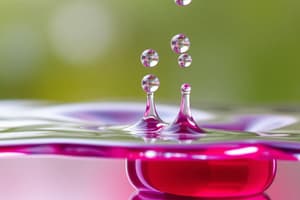Podcast
Questions and Answers
Which type of solid is characterized by a fixed geometric pattern or lattice structure, resulting in a regular and repeating arrangement of its components?
Which type of solid is characterized by a fixed geometric pattern or lattice structure, resulting in a regular and repeating arrangement of its components?
- Molecular solid
- Crystalline solid (correct)
- Covalent Network solid
- Amorphous solid
What is the primary force responsible for holding molecules together in molecular crystals?
What is the primary force responsible for holding molecules together in molecular crystals?
- Metallic bonds
- Covalent bonds
- Ionic bonds
- Van der Waals forces (correct)
What is the key characteristic that distinguishes crystalline solids from amorphous solids?
What is the key characteristic that distinguishes crystalline solids from amorphous solids?
- Crystalline solids have a regular, repeating arrangement of atoms or ions. (correct)
- Crystalline solids are better conductors of heat and electricity.
- Crystalline solids are generally more brittle.
- Crystalline solids have a higher melting point.
Which type of solid is typically characterized by its high melting point, strong electrostatic interactions, and brittleness?
Which type of solid is typically characterized by its high melting point, strong electrostatic interactions, and brittleness?
What is the primary type of bonding present in Covalent Network crystals?
What is the primary type of bonding present in Covalent Network crystals?
Which of these statements is TRUE about the relationship between intermolecular forces and boiling point?
Which of these statements is TRUE about the relationship between intermolecular forces and boiling point?
Which of the following types of solids is MOST likely to be a good conductor of electricity in its solid state?
Which of the following types of solids is MOST likely to be a good conductor of electricity in its solid state?
What is the smallest repeating unit of a crystal lattice called?
What is the smallest repeating unit of a crystal lattice called?
What property of a fluid measures its resistance to flow?
What property of a fluid measures its resistance to flow?
Which factor contributes to higher viscosity in a liquid?
Which factor contributes to higher viscosity in a liquid?
What is the effect of hydrogen bonding on a liquid's viscosity?
What is the effect of hydrogen bonding on a liquid's viscosity?
What phenomenon explains the tendency of a liquid to rise in narrow tubes?
What phenomenon explains the tendency of a liquid to rise in narrow tubes?
What occurs when the rate of evaporation and the rate of condensation of a liquid become equal?
What occurs when the rate of evaporation and the rate of condensation of a liquid become equal?
What is the primary cause of surface tension in a liquid?
What is the primary cause of surface tension in a liquid?
What describes adhesion in the context of liquids?
What describes adhesion in the context of liquids?
Which term describes the curved surface of a liquid in a container?
Which term describes the curved surface of a liquid in a container?
What happens to vapor pressure as temperature increases?
What happens to vapor pressure as temperature increases?
How does the strength of intermolecular forces affect vapor pressure?
How does the strength of intermolecular forces affect vapor pressure?
What is the normal boiling point of water?
What is the normal boiling point of water?
What does the molar heat of vaporization (ΔHvap) indicate?
What does the molar heat of vaporization (ΔHvap) indicate?
What criteria define a crystalline solid?
What criteria define a crystalline solid?
What type of bonding holds ions together in an ionic compound?
What type of bonding holds ions together in an ionic compound?
What occurs at the boiling point of a liquid?
What occurs at the boiling point of a liquid?
What unique characteristic does a covalent network crystal have?
What unique characteristic does a covalent network crystal have?
Flashcards
Viscosity
Viscosity
A measure of a fluid's resistance to flow. The higher the viscosity, the slower the fluid flows.
Surface Tension
Surface Tension
The elastic force at the surface of a liquid. It's like a 'skin' that makes it hard to break the surface.
Capillary Action
Capillary Action
The tendency of a liquid to rise in narrow tubes or small openings due to intermolecular attractions.
Cohesion
Cohesion
Signup and view all the flashcards
Adhesion
Adhesion
Signup and view all the flashcards
Meniscus
Meniscus
Signup and view all the flashcards
Vapor
Vapor
Signup and view all the flashcards
Vaporization
Vaporization
Signup and view all the flashcards
Vapor Pressure
Vapor Pressure
Signup and view all the flashcards
Convex Meniscus
Convex Meniscus
Signup and view all the flashcards
Concave Meniscus
Concave Meniscus
Signup and view all the flashcards
Molar Heat of Vaporization (ΔHvap)
Molar Heat of Vaporization (ΔHvap)
Signup and view all the flashcards
Boiling Point
Boiling Point
Signup and view all the flashcards
Normal Boiling Point
Normal Boiling Point
Signup and view all the flashcards
Crystal or Crystalline solid
Crystal or Crystalline solid
Signup and view all the flashcards
Molecular Crystal
Molecular Crystal
Signup and view all the flashcards
Crystal Lattice
Crystal Lattice
Signup and view all the flashcards
Unit Cell
Unit Cell
Signup and view all the flashcards
Covalent Bond
Covalent Bond
Signup and view all the flashcards
Intermolecular Forces
Intermolecular Forces
Signup and view all the flashcards
Crystalline Solid
Crystalline Solid
Signup and view all the flashcards
Amorphous Solid
Amorphous Solid
Signup and view all the flashcards
Ionic Crystal
Ionic Crystal
Signup and view all the flashcards
Study Notes
Properties of Liquids and Intermolecular Forces
- Fluid: A substance that can flow (gas or liquid).
- Surface Tension: The elastic force in a liquid's surface, the energy needed to increase/stretch the surface area of a liquid by a unit area. Similar to an elastic film.
- Viscosity: A measure of a liquid's resistance to flow. Higher viscosity = slower flow. Measured in centipoise. Water (20°C) = 1 centipoise (0.001 Pa/s). Viscosity increases with stronger intermolecular forces and larger molecule size.
- Capillary Action: The tendency of a liquid to rise or be drawn into narrow tubes or openings. Driven by intermolecular attraction (cohesion and adhesion) between the liquid and the solid material. Cohesion = attraction between liquid molecules, adhesion = between unlike molecules.
- Meniscus: The curved surface of a liquid in a container. Concave meniscus forms when adhesion is stronger than cohesion, convex meniscus forms when cohesion is stronger than adhesion.
Vapor Pressure and Equilibrium
- Vapor: Gaseous substance that exists as a liquid or solid at normal temperatures.
- Vapor Pressure: The rate of condensation of gas equals the rate of evaporation of liquid = equilibrium. The maximum vapor pressure of a liquid at a given temperature. It increases with temperature.
Properties of Solids and Intermolecular Forces
- Crystalline Solid: A solid with components (atoms, molecules, or ions) arranged in a highly ordered microscopic structure.
- Amorphous Solid: A solid with randomly oriented components. Considered supercooled liquids, examples include glass, plastic, coal, and rubber.
- Ionic Crystal: A solid made up of positively and negatively charged ions held together by electrostatic forces.
- Network Solid (Covalent Network Crystal): A solid in which atoms are bonded by covalent bonds in a continuous network extending throughout the material.
- Molecular Crystal: A solid made up of molecules held together by van der Waals forces.
- Unit Cell: The smallest subunit of a crystal lattice that can be repeated over and over to create the entire crystal.
- Ion: An atom or group of atoms with a net positive or negative charge.
- Electrostatic Bonding: The attraction between oppositely charged ions in a chemical compound.
Types of Solids
-
Crystalline Solids: Fixed, repeating, geometric patterns (lattices). Example: NaCl, CuSO4, sugar.
-
Crystalline solids exhibit a high level of order, in terms of crystal lattices, which are the basic repeating units within their structure. At a molecular level, all crystals exhibit a repeating pattern for how atoms, molecules, or ions are organized within the solid.
-
Amorphous solids lack the highly ordered structure of crystalline solids. These solids have disordered arrangements of atoms, ions, or molecules, which may be supercooled liquids or a liquid at that particular temperature.
-
Amorphous Solids: Random orientations of components. Example: glass, plastic, rubber.
-
Metallic Crystals: Electrostatic interactions between cations and delocalized electrons (sea of electrons). Examples include Iron, Silver, Gold.
-
Ionic Crystals: Strong electrostatic interactions between cations and anions. Examples include NaCl, Ca(NO3)2.
-
Molecular Crystals: Molecules held together by van der Waals forces. Examples include noble gases, methane, sucrose, and dry ice.
-
Covalent Network Crystals: Atoms held together by covalent bonds in a continuous network. Examples include diamond (C) and quartz (SiO2).
Studying That Suits You
Use AI to generate personalized quizzes and flashcards to suit your learning preferences.




